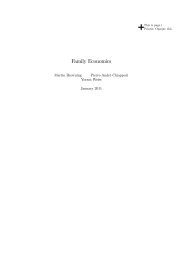Bounded Rationality in Industrial Organization
Bounded Rationality in Industrial Organization
Bounded Rationality in Industrial Organization
Create successful ePaper yourself
Turn your PDF publications into a flip-book with our unique Google optimized e-Paper software.
product differentiation. Firms will <strong>in</strong>vest <strong>in</strong> obfuscation just as they <strong>in</strong>vest <strong>in</strong> differention<br />
to raise markups. The equilibrium markups for a given error distribution can be derived<br />
as <strong>in</strong> Perloff and Salop (1985). 9 Gabaix and Laibson derive new results on the asymptotic<br />
rate at which markups decl<strong>in</strong>e as the number of firms <strong>in</strong>creases, and emphasize that for<br />
some error distributions add<strong>in</strong>g firms to the market will drive down prices very slowly.<br />
Spiegler (2006) discusses another rule-of-thumb model. In his model, products <strong>in</strong>herently<br />
have a large number of dimensions. <strong>Bounded</strong>ly rational consumers evaluate products<br />
on one randomly chosen dimension and buy the product that scores most highly on this<br />
dimension. In this model, consumers would evaluate the products correctly if products were<br />
designed to be equally good on all dimensions. Spiegler shows that this will not happen,<br />
however. Essentially, firms randomize across dimensions mak<strong>in</strong>g the product very good on<br />
some dimensions and not so good on others. He th<strong>in</strong>ks of this cross-dimensional variation<br />
as <strong>in</strong>tentional obfuscation. The comparative statics of the model may help us understand<br />
why there is more obfuscation <strong>in</strong> some markets than <strong>in</strong> others: obfuscation <strong>in</strong>creases when<br />
there are more firms <strong>in</strong> the market, and when the outside option is more attractive.<br />
5.5 Add-on pric<strong>in</strong>g<br />
In many <strong>in</strong>dustries, it is common to sell high-priced add-ons. Hotels charge high prices<br />
for dry clean<strong>in</strong>g, telephone calls, m<strong>in</strong>ibar items, and restaurant meals. Credit cards have<br />
high late-payment fees. Upgrad<strong>in</strong>g to a larger hard drive and add<strong>in</strong>g more memory adds<br />
substantially to the advertised price of a Dell computer.<br />
Ellison (2005) notes that we can th<strong>in</strong>k of high add-on prices <strong>in</strong> a couple ways. One is<br />
that we may simply be see<strong>in</strong>g the outcome of a standard multi-good price discrim<strong>in</strong>ation<br />
model. Suppose that consumers who are more price-sensitive when choos<strong>in</strong>g between firms<br />
(“cheapskates”) also have a lower will<strong>in</strong>gness to pay for quality-improv<strong>in</strong>g add-on. 10 Then,<br />
9 Perloff and Salop is an exception to my earlier remark about departures from rationality <strong>in</strong> 1980’s IO<br />
papers be<strong>in</strong>g un<strong>in</strong>tended or unwanted. They have a brief section <strong>in</strong> the back of their paper not<strong>in</strong>g that<br />
the ɛ’s <strong>in</strong> their model could capture “ ‘spurious’ as well as actual product differentiation”. They mention<br />
Chamberl<strong>in</strong> and Galbraith as among those who had previously discussed spurious differentiation and po<strong>in</strong>t<br />
to bl<strong>in</strong>d taste tests as provid<strong>in</strong>g empirical support for its importance.<br />
10 I would argue that this assumption is the most natural one to make. Note, however, that it does<br />
differ from what is assumed <strong>in</strong> most papers discussed <strong>in</strong> Armstrong (2006) and Stole (2005). The standard<br />
assumption has been that brand preferences and quality preferences are <strong>in</strong>dependent.<br />
22













